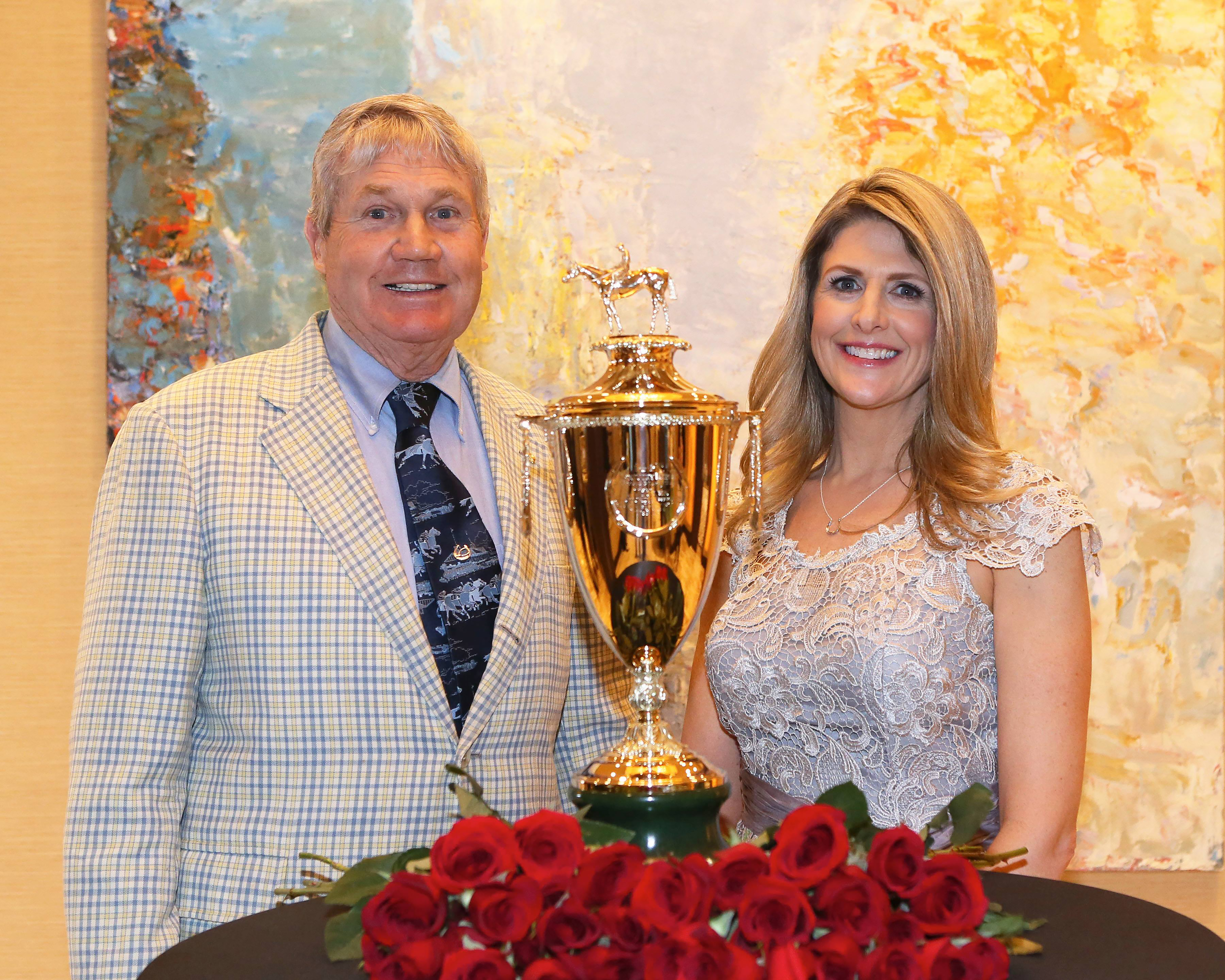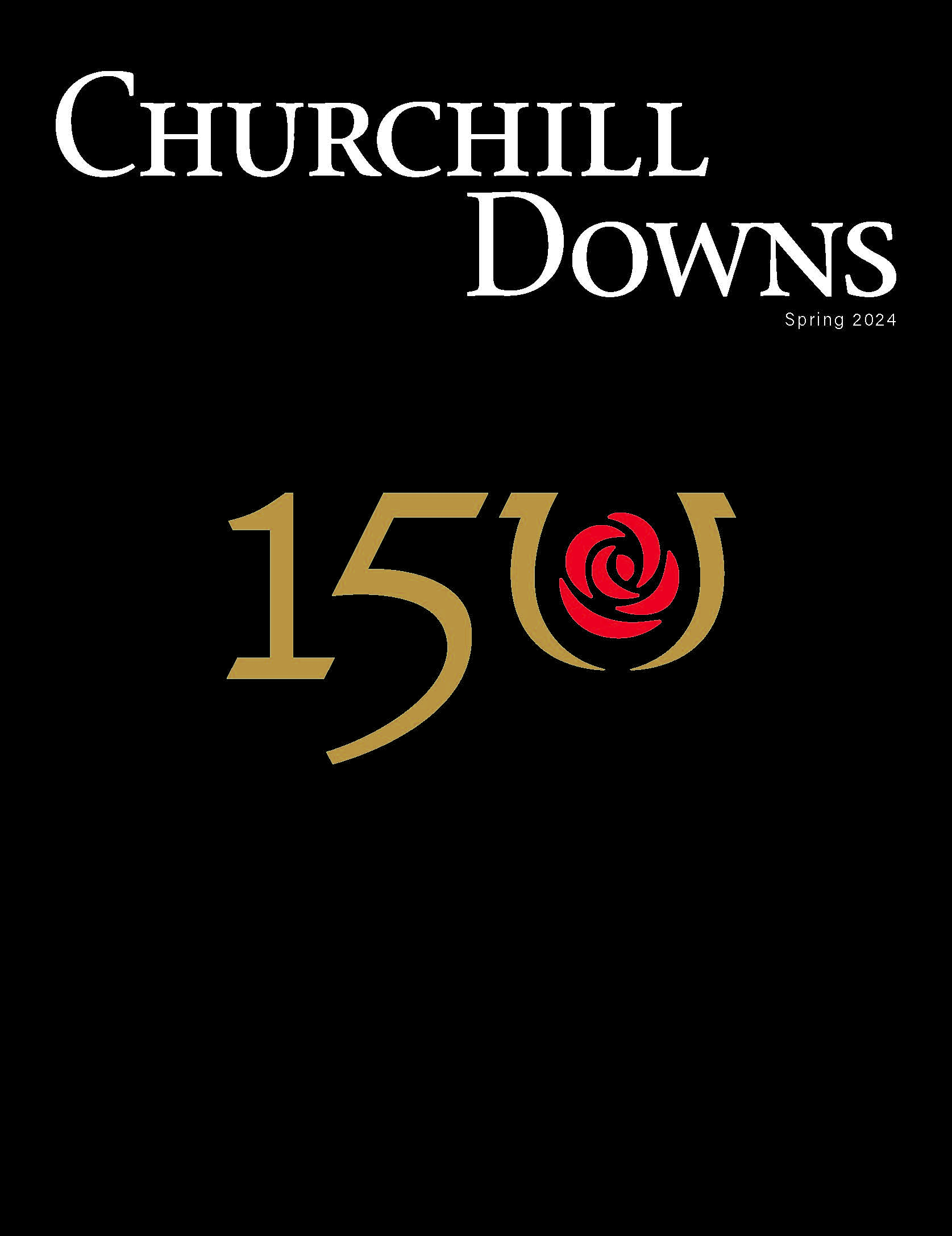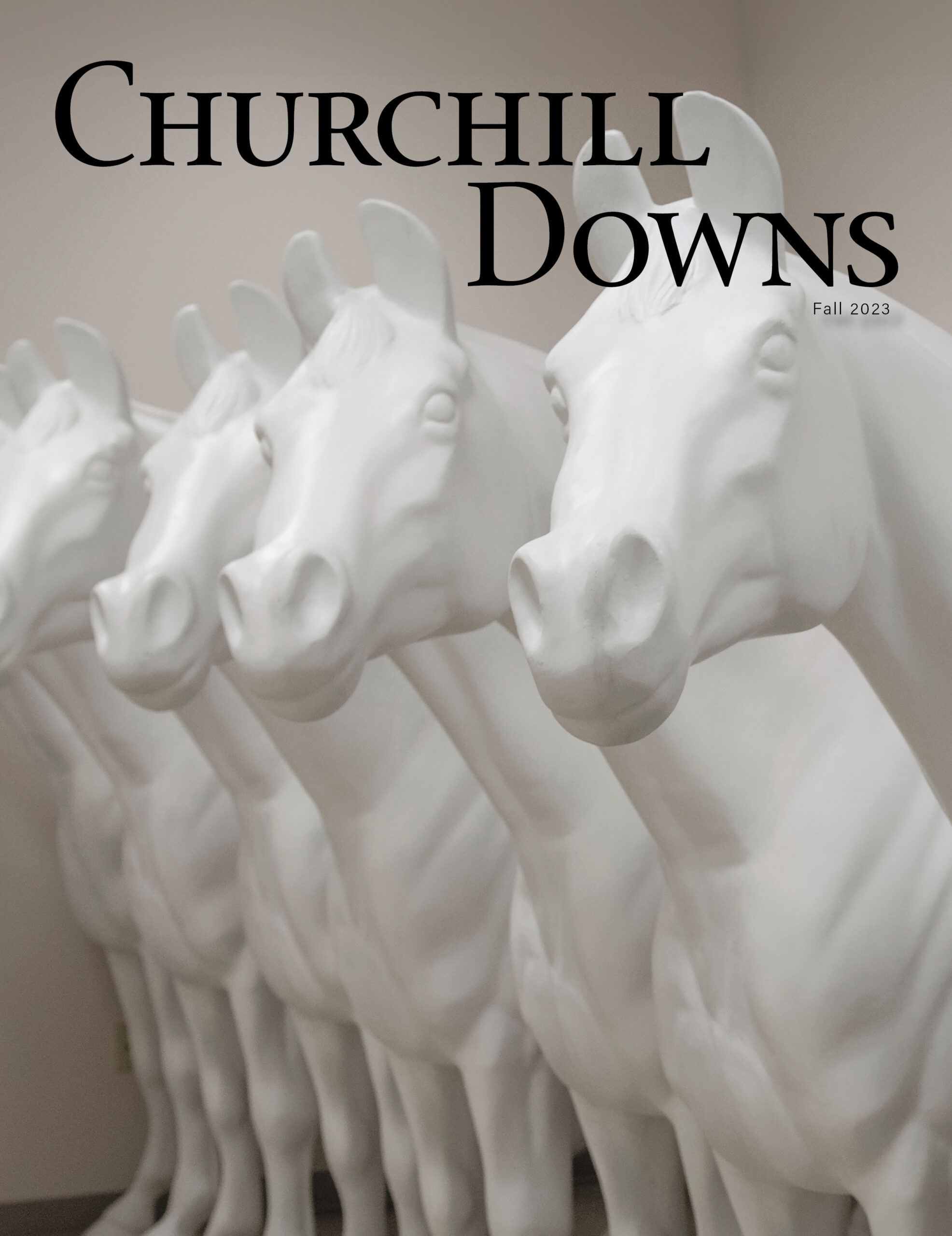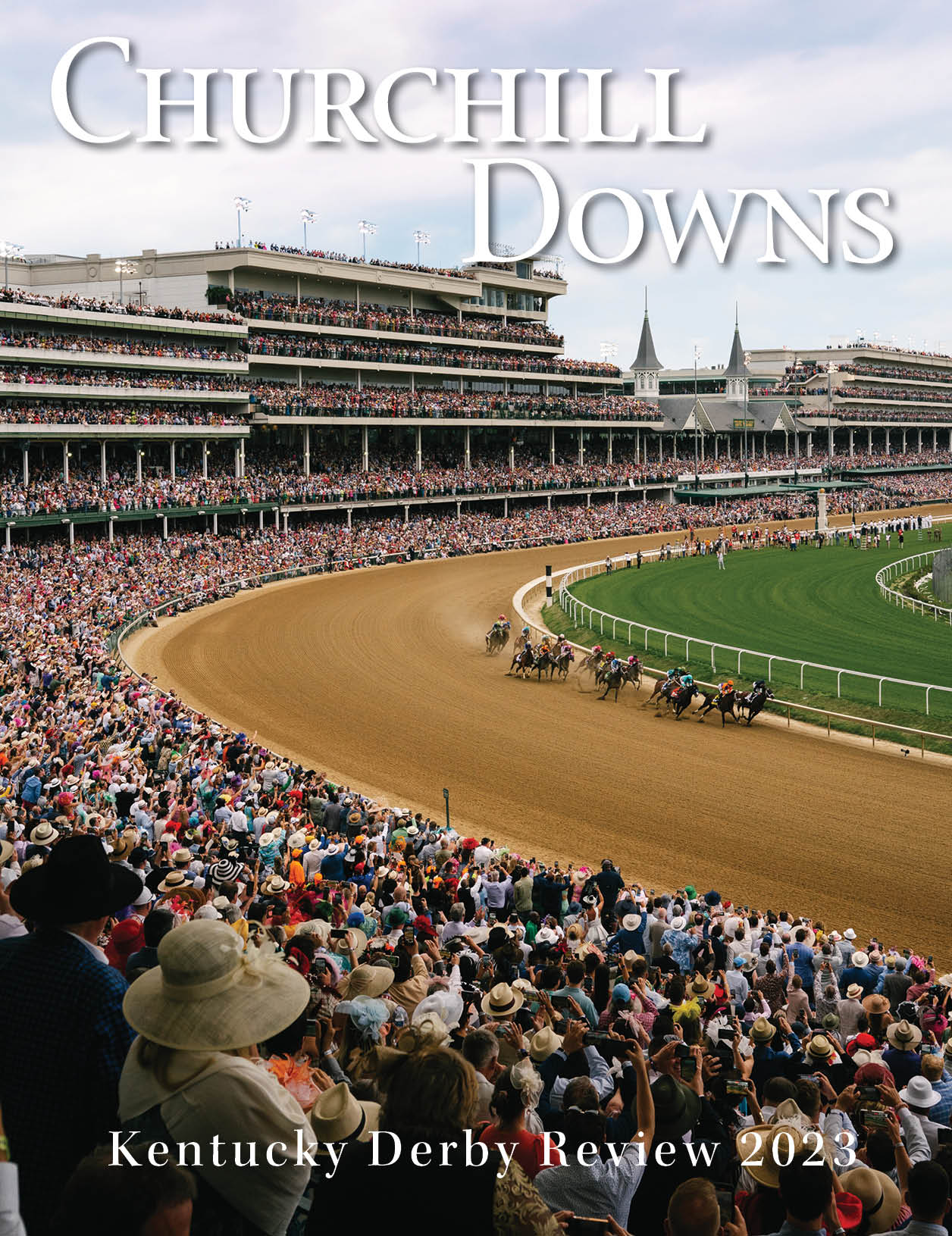Gold Standard
The 2024 Kentucky Derby Trophy Gets a Bold and Bejeweled New Look to Celebrate the 150th Run for the Roses.
Written by Laura Ross, Photography by Coady Photography and Brian Moriarty Photography and Courtesy of S.R. Blackington and NBC Sports
Susanne Blackinton quietly says, “I hope this year’s gold cup would have pleased him.” Her voice trailing off into a lost memory. Sometimes, dreams do come true.
Blackinton lives her dream. As the creator of the Kentucky Derby winning gold trophy, she revels in being a fifth-generation silversmith for her family’s firm, S.R. Blackinton, in Smithfield, Rhode Island. For the past 50 years, S.R. Blackinton (formerly New England Sterling), originally led by Susanne’s late father Ross, has hand crafted the Kentucky Derby winning trophy. Every trophy created at S.R. Blackinton is a true piece of art, but the trophy to celebrate the 150th Kentucky Derby is exquisitely detailed and covered in precious jewels.
Just like her dad wanted.
Ross Blackinton was diagnosed with a rapid form of ALS in late October 2020. It was a crushing blow to a man who worked so brilliantly with minute details and artful sculpting every day of his long and lasting career. “He surrendered to God,” Blackinton says. “But every day he would call when I wasn’t there, and say, ‘Hi honey, I have an idea.’ He always wanted to discuss the 150th Derby gold cup. ALS was robbing him of his voice, so it was difficult to speak much, still he discussed how we needed to make a blanket of rubies and be sure to put diamonds in the horseshoe. We were still four years out at that point, but he knew he would not be here, so he wanted to make sure he had his two cents in it. He was very adamant about getting his words and vision out.”
Sadly, Ross Blackinton passed away just weeks later in December 2020 at the age of 81. To honor her father and the golden legacy of the Derby gold trophies he had left behind, Susanne set out to make his bejeweled dream a reality. A trophy of this historical importance had to be perfect. She knew it had to be extraordinary and unique.
History is fuzzy if a trophy was presented in 1875 at the first Kentucky Derby and little is known if there was an official trophy presentation in ensuing years. In 1922, a six-piece gold buffet service with a pair of candlesticks and a loving cup was given to Ben Block, the owner of the winning horse Morvich. The following year in 1923, the owners of Zev were presented with the first version of a Kentucky Derby winning trophy.
The following year, legendary Churchill Downs Racetrack President Col. Matt J. Winn commissioned a standard design to be developed for the “Golden Anniversary” of the Derby. Col. Winn asked Louisville jewelers Lemon & Sons to work with artist George Graff to design what would become the iconic trophy. Once the design was finalized, Redlich & Company created the first trophy and it was presented in 1924 to Rosa Hoots, owner of the 50th Kentucky Derby winner, Black Gold.
One hundred years later, the general look of the trophy remains nearly the same. Only one notable design alteration has been made since the first gold cup was commissioned in 1924. For the 125th running of the Kentucky Derby in 1999, the direction of the horseshoe was changed from pointing down – which signifies bad luck – to pointing upwards – so the luck doesn’t run out. The trophy is believed to be the only solid gold trophy that is annually awarded to the winner of a major American sporting event.
The special gold and jeweled 150th Kentucky Derby trophy was handcrafted from 14-karat solid yellow gold and green gold over a period of more than seven months. The original dies and molds created in 1924 are still used 100 years later to craft each and every one.
As always, the front of the trophy is adorned by a 14-karat gold horseshoe, the top features a 14-karat gold horse and rider and the sides showcase a pair of horseshoe-shaped wreath handles. Overall, the trophy stands 22 inches tall and weighs just under 68 ounces, excluding its jade base and unique gems added to this year’s milestone trophy.
The Blackinton family took over the design and production of the trophy 50 years ago. At the time, Ross Blackinton had recently sold his father’s company and started his own. One of his customers was Tiffany and Company, who convinced him to purchase a holloware company in New York called Elgin. “No one knew at the time that the company made the Derby trophy,” explains Susanne. “Later that year, Lemon & Sons in Louisville contacted my dad and that’s where it started.”
Ross Blackinton partnered with his friend Walter Bigos, a silversmith, and together they took on the Derby trophy production. Bigos would become Susanne’s mentor and beloved “second father” who taught her and her husband, Bill Juaire, their beloved and incredible craft. Bill began spinning the Derby trophy in 1990 and Susanne created her first solo trophy in 2007. Today, Bill and Susanne are mentoring their daughter Skyla to become the sixth generation of the Blackinton family to be a silversmith.
In previous special anniversary years – 1949 (75th), 1974 (100th) and 1999 (125th) – the winning trophy was embellished with some jewels. When Susanne and Churchill Downs officials began discussing plans for the 2024 trophy, comments were made about the jewels added to the 125th anniversary trophy. Susanne didn’t want to do just a replica – she knew she had to incorporate her father’s extraordinary vision into the milestone celebration.
“We looked at photos of the actual Garland of Roses and one of the first things we really noticed was the greenery,” Susanne says. “I thought it’d be fun to use emeralds on the blanket itself, so it’s not just the blanket of red rubies. It has the greenery, but it had to look authentic. I’m a silversmith, not a stone setter, so I was referred to Baxter’s Fine Jewelry in Warwick, Rhode Island, and they helped bring our vision of ‘leaves’ to life by using marquis emeralds. They were able to use new technologies to make the stones and blanket form really nicely to the jockey. The stones are all set into the blanket in a very classy and clean way.”
The jewels are all natural stones and add an impressive splash of color with over 23 carats of gems. The Garland of Roses resting on the winning horse topping the trophy contains 196 round rubies, 36 round emeralds and 96 marquise emeralds. The cover cape beneath the horse has
12 round brilliant diamonds and the braid contains 38 cabochon rubies. The lucky horseshoe sparkles with 8 diamonds on the front of the trophy.
Handcrafting the gold trophy into being is an arduous and painstakingly delicate task. “There are two big misconceptions about the trophy,” Susanne says. “One is that you just pour the gold into a mold and you have a trophy. The other is that the trophy isn’t solid gold. It’s definitely solid 14-carat gold, and it is definitely not poured into a big mold.”
Gold is poured into a small horse mold, but even from there, it’s very rough and raw. “There’s a lot of handwork that goes into it,” Susanne explains. “Polishing, casting, kind of grinding in to give it hair, brushes and fine tuning the mane. The horse’s bits and reins are all handmade from just gold wire. So many of those small parts are handmade.”
Her husband Bill takes weeks to spin the body of the trophy, carefully manipulating the 14-carat gold. It’s a meticulous process that takes an immense amount of patience and artistry. One wrong move, one misplaced flame of soldering heat, one badly set precious stone can spell disaster. Much can go wrong, but when it goes right? A truly magical result is the final product of months of planning and crafting.
Even then, the team at S.R. Blackinton are not finished putting their craft into action for Churchill Downs. Three smaller sterling silver replica trophies are crafted that go to the winning jockey, breeder and trainer of each Kentucky Derby winner.
The gold and jewel-encrusted trophy was unveiled at the beginning of February during a media event held in Churchill Downs’ First Turn Club and then embarked on a preview tour at various events nationwide in advance of the Derby. Eagle-eyed Louisvillians will also get a peek of the trophy at several local sporting events held throughout the month of April.
The trophy has traveled safely, a feat Susanne notes carefully. “My dad and Walter were quite the comedy team,” Susanne laughs. “Years ago, they would hand deliver the trophy. They arrived early at the airport one year, so they went to the bar to wait. Suddenly, they heard their names being called over the speakers because their plane was ready to leave. So, they ran through the airport, and then they both looked at each other and asked, who’s got the trophy? They realized they had left it at the bar, so they had to run back. My dad was able to get them to hold the plane. They sweated that one out. I’m sure it travels much more securely these days!”
Continuing the family tradition of creating the Kentucky Derby trophy was a long-held dream for Susanne. “I told my high school jewelry teacher, someday I’ll make the Kentucky Derby trophy. I don’t think I really believed it. So now, to have that dream come true is amazing; and not only that, but to be doing it with my husband and daughter is incredible.”
All the hard work, all the preparation, all the angst and bliss – it all comes together in a rush of sweet success when the impossible becomes reality. It’s a win to savor. One of Susanne’s proudest moments is that famed First Saturday in May when the trophy ceremony takes place in the Winner’s Circle at Churchill Downs.
“I love that,” she says. “That’s one of my favorite moments because one thing I always say is the hardest part of making the trophy sometimes is just letting it go, packing it up and shipping it out because we’re finally done. I don’t want to let it go, but then it’s fantastic seeing the jockey lift the cup and kiss it and you see their smiles and everyone is so happy. That’s just such a great feeling.”
In 1938, Churchill Downs produced a commemorative official Kentucky Derby Glass that it used on dining tables throughout the track on Derby Day. Not surprisingly, patrons swiped their glasses at the end of the day and promptly carried them away as souvenirs. Instead of being angry, Churchill Downs officials saw an opportunity. The following years, they decided to produce the glasses for sale, and before long, a cherished tradition was born.
Today, the water glasses are used primarily as Mint Julep Glasses and are widely available – and collectible. Each year features a unique design and a list of past Derby winners. A cottage industry has grown up around the glasses, with certain years and designs selling and trading for over $30,000 a glass. Most glasses, however, are very affordable and make fun collectibles for Derby fans and party hosts worldwide. The 150th official Kentucky Derby Mint Julep Glass is sure to become a popular collectible. It is adorned with the classic Kentucky Derby red roses and lists, per tradition, every official Kentucky Derby winner – from Aristides in 1875 to Mage in 2023.
Amy Seiler and her husband Michael are one of the foremost authorities on the history of the official Kentucky Derby Glasses. Together, they operate Derby Glass Warehouse (www.derbyglasswarehouse.com) where they buy, sell and trade Kentucky Derby Glasses to eager fans and collectors across the globe.
They became interested in Kentucky Derby Glassware in the early 2000s and began their business selling those they had collected on eBay. That soon morphed into a full website and the couple began buying and selling full collections from estates and serious collectors. Seiler says there has been a huge boom in the market over just the past five years. “The glasses are very unique every year and are their own little art piece,” she shares. “It is very easy to build a decent collection at a reasonable price. Now obviously, if you get some of the rarer glasses, that does increase substantially, but for a regular collector, you can have a pretty nice collection and have it not cost an arm and a leg, which makes it an easy and fun hobby.”
The most sought-after glass is the 1940 dated glass, of which only 800 were produced. In the beginning, only small production runs occurred, and with the advent of World War II, glass was rationed across the United States, making this one of the most collectible pieces of drinkware in the world.
“The 1940 glass is extremely rare and could sell for upwards of $40,000,” says Seiler. “There are a lot of people out there looking for that one.”
Generally, all of the wartime-era glasses are considered highly collectible. With the ration in place, Churchill Downs needed to be creative about the glass production, so they identified a glassware company in New York that was closing and bought every single piece of inventory of a certain cup style. This workaround explains why there were multiple color schemes for those years and provides an even more sought-after piece of history.
“They’re kind of hard to explain,” says Seiler. “It’s almost like a super hard plastic resin glass. They’re not as breakable and they are a little bit more affordable than the 1940 glass. You’ll also see in 1945, there’s a short version of a glass and then there’s a tall high ball version. I think it’s very interesting at that time, Churchill Downs really took efforts to keep this tradition going through wartime.”
Production errors that caused Churchill Downs headaches at the time are now seen as highly valued and rare finds. The 1956 glass had a varying number of stars and horse tails misprinted. “I’m not sure what happened on the various production lines that year, but obviously, all the horses are supposed to have tails and all the jockeys are supposed to have heads,” Seiler laughs, “but, on these glasses, you’ll find stars missing, or a tail or two missing. And on some, there is a coveted run of glasses with a headless jockey.”
Seiler and her husband travel the country to find much loved collections from estates. They personally picked up a substantial collection from a sale in Arizona, and had clients in Chicago, where an estate had multiple glasses from 40 years ago onward, all with detailed notes from the original owners who would travel by bus to Louisville with friends each Derby. They carefully noted all the details of each trip, the hotels they stayed in, the meals they enjoyed, and of course, the glasses they brought back with them. “It was like a little historical snapshot of every year’s trip, which was fascinating to read,” says Seiler.
International interest is strong as well, with the Seilers shipping collections as far as Australia. They frequently ship to Canada and Europe and Seiler notes it has a lot to do with a happy memory. “The Derby is often a once in a lifetime trip for people,” she explains. “You bring home this simple little glass, but you also bring home huge memories. Ordering and building a collection of glassware then becomes a very easy and obtainable goal.”
Seiler has worked with celebrities and serious collectors, but loves finding treasure in mom-and-pop collections. “It’s fascinating sometimes, when you find some collections,” she shares. “Last year, we helped an elderly man and his grandson clear out his collection. Unfortunately, he had kept the glasses in less than stellar condition, in a cellar under his house, so there was a lot of damage. He probably had several hundreds of thousands of dollars’ worth of glasses scattered over his property.”
While Seiler and her husband have helped avid collectors across the world, one particular Derby Glass connoisseur stands out amongst the rest – Churchill Downs CEO, Bill Carstanjen. What started as a childhood hobby, Carstanjen’s love of collecting would eventually lead him to Seiler and a fully complete collection of Derby Glasses, the marvel of fellow collectors across the world.
Of his noteworthy Derby Glass collection, Carstanjen shares that he hadn’t been particularly committed to pursuing a complete collection but had acquired the most recent designs naturally during his time at Churchill Downs. Meanwhile, his wife, Julia, had been picking up the glasses when she saw them in antique stores as part of the family’s close and personal connection to the famed race. Without a particular strategy behind her purchases, she had generated quite a robust collection.
“One day, I lined up all the Derby Glasses in our home, and realized that without really trying, Julia had acquired glasses that spanned about 50 years,” Carstanjen recounts. “This activated the collector in me who loves a challenge.”
The Carstanjen collection now begins with the 64th Kentucky Derby in 1938 and now includes this year’s glass commemorating the 150th Kentucky Derby. “Once I got interested, I started doing research to see how I could get a complete set,” he shares. “Some I was able to find on my own, but the distant decades started to get harder to source.”
Now fully realized, the Carstanjen collection features some of the most difficult-to-find glasses, including various color differences from the World War II era and the headless jockey from 1956, of which he is most proud. The collection even boasts the 24K gold versions of the famed glassware, limited edition runs of certain years that include the designs etched in gold onto the glass.
Until 1974, Derby Glasses were exclusively sold at Churchill Downs, but then they identified an opportunity to allow certain retailers to sell the glasses. While this business model led to an increase in production, it also lowered the long-term values as the glasses were more ubiquitous and widely available.
“This year, we’re giving a nod to those serious collectors and increased the challenge again by issuing a special frosted Derby Glass that will only be available on site at Churchill Downs on Derby Day,” explains Carstanjen. “If you aren’t there in person, you may enjoy the hunt of trying to get your hands on this limited special edition.” An enjoyment only a true collector like himself can appreciate, he adds with a laugh, “You’ll have to work for it.”
The on-site exclusive glass will feature a frosted casing with a gold trophy, adding a priceless piece of memorabilia to the historic occasion. A frosted version of the Oaks Lily Glass will also be available only for those attending the Kentucky Oaks in person this year. Exclusivity isn’t just reserved for the Grandstand and dining rooms, however, even the Infield will have its own plastic version for grabs.
While Seiler is always thrilled to see the joy that she can help bring to individuals across the globe by helping them fulfill their Derby Glass dreams, she enjoys her own personal fulfillment in the process, as well. From over-the-top artwork to simple and clean logos, she appreciates the span of design that references specific inspiration or the celebratory nature of the time. Her favorite glass?
“I really love the 1978 glass,” she admits. “I think it’s a cool glass that is a true sign of the times – a seventies-style appearance that is almost tie-dye in nature. It’s visually striking and includes nearly every color imaginable.”
Whether working with a professional like Seiler, employing your own eagle eye when antiquing or thrifting, or carrying home your glass home from the racetrack, the Churchill Downs’ Mint Julep Glassware is the perfect way to relive your Kentucky Derby memories all year, every year.




